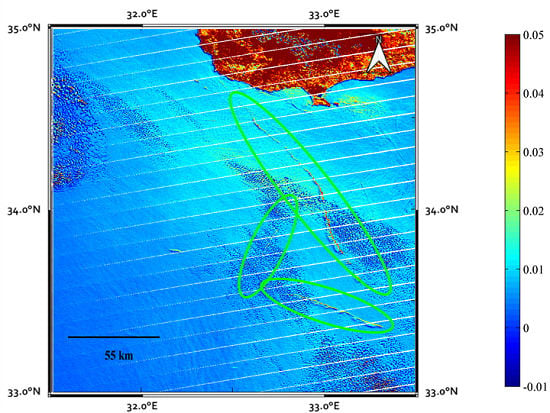A MODIS-Based Robust Satellite Technique (RST) for Timely Detection of Oil Spilled Areas
Abstract
:1. Introduction
2. Materials and Methods
3. Results and Discussion
3.1. RST Implementation
3.2. Confutation Analysis
3.3. Discussion
4. Conclusions
Acknowledgments
Author Contributions
Conflicts of Interest
References
- Kostianoy, A.; Litovchenko, K.; Lavrova, O.; Mityagina, M.; Bocharova, T.; Lebedev, S.; Stanichny, S.; Soloviev, D.; Sirota, A.; Pichuzhkina, O. Operational Satellite Monitoring of Oil Spill Pollution in the Southeastern Baltic Sea: 18 Months Experience. Environ. Res. Eng. Manag. 2006, 4, 70–77. [Google Scholar]
- Kvenvolden, K.A.; Cooper, C.K. Natural seepage of crude oil into the marine environment. Geo Mar. Lett. 2003, 23, 140–146. [Google Scholar] [CrossRef]
- Maribus. World Ocean Review, 2010. Available online: http://worldoceanreview.com/wp-content/downloads/wor1/WOR1_english.pdf (accessed on 28 November 2016).
- Liu, Y.; MacFadyen, A.; Ji, Z.G.; Weisberg, R.H. (Eds.) Monitoring and Modeling the Deepwater Horizon Oil Spill: A Record-Breaking Enterprise; Geophysical Monograph Series; AGU: Washington, DC, USA, 2011; Volume 195, p. 271.
- Leifer, I.; Lehr, W.J.; Simecek-Beatty, D.; Bradley, E.; Clark, R.; Dennison, P.; Huf, Y.; Mathesone, S.; Jones, C.E.; Holtg, B.; et al. State of the art satellite and airborne marine oil spill remote sensing: Application to the BP Deepwater Horizon oil spill. Remote Sens. Environ. 2012, 124, 185–209. [Google Scholar] [CrossRef]
- Pavlakis, P.; Sieber, A.; Alexandry, S. Monitoring oil-spill pollution in the Mediterranean with ERS SAR. Oceanogr. Lit. Rev. 1997, 9, 1067. [Google Scholar]
- Fiscella, B.; Giancaspro, A.; Nirchio, F.; Pavese, P.; Trivero, P. Oil spill detection using marine SAR images. Int. J. Remote Sens. 2000, 21, 3561–3566. [Google Scholar] [CrossRef]
- Miranda, F.P.; Marmol, A.M.Q.; Pedroso, E.C.; Beisl, C.H.; Welgan, P.; Morales, L.M. Analysis of RADARSAT-1 data for offshore monitoring activities in the Cantarell Complex, Gulf of Mexico, using the unsupervised semivariogram textural classifier (USTC). Can. J. Remote Sens. 2004, 30, 424–436. [Google Scholar] [CrossRef]
- Brekke, C.; Solberg, A.H.S. Review on Oil spill detection by satellite remote sensing. Remote Sens. Environ. 2005, 95, 1–13. [Google Scholar] [CrossRef]
- Ferraro, G.; Bernardini, A.; David, M.; Meyer-Roux, S.; Muellenhoff, O.; Perkovic, M.; Tarchi, D.; Topouzelis, K. Towards an operational use of space imagery for oil pollution monitoring in the Mediterranean basin: A demonstration in the Adriatic Sea. Mar. Pollut. Bull. 2007, 54, 403–422. [Google Scholar] [CrossRef] [PubMed]
- Akkartal, A.; Sunar, F. The usage of RADAR images in oil spill detection. Int. Arch. Photogramm. Remote Sens. Spat. Inf. Sci. 2008, 37, 271–277. [Google Scholar]
- Marghany, M. Utilization of a genetic algorithm for the automatic detection of oil spill from RADARSAT-2 SAR satellite data. Mar. Pollut. Bull. 2014, 89, 20–29. [Google Scholar] [CrossRef] [PubMed]
- Fingas, M.; Brown, C. Review of oil spill remote sensing. Mar. Pollut. Bull. 2014, 83, 9–23. [Google Scholar] [CrossRef] [PubMed]
- Chust, G.; Sagarminaga, Y. The multi-angle view of MISR detects oil slicks under sun glitter conditions. Remote Sens. Environ. 2007, 107, 232–239. [Google Scholar] [CrossRef]
- Feng, J.; Chen, H.; Bi, F.; Li, J.; Wei, H. Detection of oil spills in a complex scene of SAR imagery. Sci. China Technol. Sci. 2014, 57, 2204–2209. [Google Scholar] [CrossRef]
- Trivero, P.; Adamo, M.; Biamino, W.; Borasi, M.; Cavagnero, M.; De Carolis, G.; Di Matteo, L.; Fontebasso, F.; Nirchio, F.; Tataranni, F. Automatic oil slick detection from SAR images: Results and improvements in the framework of the PRIMI pilot project. Deep Sea Res. Part II Top. Stud. Oceanogr. 2016, 133, 146–158. [Google Scholar] [CrossRef]
- Agenzia Spaziale Italiana. COSMO-SkyMed. System Description & User Guide. Available online: http://www.asi.it/en/activity/observation-earth/cosmo-skymed (accessed on 28 November 2016).
- Nirchio, F.; Pandiscia, G.; Ruggieri, G.; Santoleri, R.; Tataranni, F.; Giancaspro, A.; Trivero, P.; Pinardi, N.; Masini, A.; Castellani, C. COSMO-SkyMed contribution in oil spill monitoring of the Mediterranean Sea. In Proceedings of the 2009 IEEE International Geoscience and Remote Sensing Symposium, Cape Town, South Africa, 12–17 July 2009; pp. II-781–II-784.
- Copernicus. Space Technology Reveals Where Oil Pollutes the Oceans; ESA Web Publication, Issue 21. 2013. Available online: www.copernicus.eu/sites/default/files/documents/Copernicus_Briefs/Copernicus_Brief_Issue21_OilSpill_Sep2013.pdf (accessed on 28 November 2016).
- Grimaldi, C.S.L.; Casciello, D.; Coviello, I.; Lacava, T.; Pergola, N.; Tramutoli, V. An improved RST approach for timely alert and Near Real Time monitoring of oil spill disasters by using AVHRR data. Nat. Hazard. Earth Syst. Sci. 2011, 11, 1281–1291. [Google Scholar] [CrossRef]
- Cross, A.M. Monitoring marine oil pollution using AVHRR data: observation off coast of Kuwait and Saudi Arabia during January 1991. Int. J. Remote Sens. 1992, 13, 781–788. [Google Scholar] [CrossRef]
- Hu, C.; Müller-Krager, F.E.; Taylor, C.J.; Myhre, D.; Murch, B.; Odriozola, A.L.; Godoy, G. MODIS detects oil spills in Lake Maracaibo, Venezuela. EOS Trans. AGU 2003, 84, 313–319. [Google Scholar] [CrossRef]
- Howari, F.M. Investigation of hydrocarbon pollution in the vicinity of United Arab Emirates coasts using visible and near infrared remote sensing data. J. Coast. Res. 2004, 20, 1089–1095. [Google Scholar] [CrossRef]
- Shi, L.; Zhang, X.; Seielstand, G.; Zhao, C.; He, M. Oil spill detection by MODIS images using Fuzzy Cluster and Texture Feature Extraction. In Proceedings of the IEEE OCEANS-2007-Europe, Scotland, UK, 18–21 June 2007.
- Dessì, F.; Melis, M.T.; Naitza, L.; Marini, A. MODIS data processing for coastal and marine environment monitoring: A study on anomaly detection and evolution in gulf of Cagliari (Sardinia-Italy). Int. Arch. Photogramm. Remote Sens. Spat. Inf. Sci. 2008, XXXVII Pt B8, 695–698. [Google Scholar]
- Casciello, D.; Lacava, T.; Pergola, N.; Tramutoli, V. Robust Satellite Techniques for oil spill detection and monitoring using AVHRR thermal infrared bands. Int. J. Remote Sens. 2011, 32, 4107–4129. [Google Scholar] [CrossRef]
- Grimaldi, C.S.L.; Coviello, I.; Lacava, T.; Pergola, N.; Tramutoli, V. A new RST-based approach for continuous oil spill detection in TIR range: The case of the Deepwater Horizon platform in the Gulf of Mexico. In Monitoring and Modeling the Deepwater Horizon Oil Spill: A Record-Breaking Enterprise, Geophysical Monograph Series; Liu, Y., MacFadyen, A., Ji, Z.G., Weisberg, R.H., Eds.; American Geophysical Union (AGU): Washington, DC, USA, 2011; pp. 19–31. [Google Scholar]
- Etellisi, E.A.; Deng, Y. Oil spill detection: Imaging system modeling and advanced image processing using optimized SDC algorithm. Signal Image Video Process. 2014, 8, 1405–1419. [Google Scholar] [CrossRef]
- Maianti, P.; Rusmini, M.; Tortini, R.; Dalla Via, G.; Frassy, F.; Marchesi, A.; Rota Nodari, F.; Gianinetto, M. Monitoring large oil slick dynamics with moderate resolution multispectral satellite data. Nat. Hazards 2014, 73, 473–492. [Google Scholar] [CrossRef]
- Zhao, J.; Temimi, M.; Ghedira, H.; Hu, C. Exploring the potential of optical remote sensing for oil spill detection in shallow coastal waters—A case study in the Arabian Gulf. Opt. Exp. 2014, 22, 13755–13772. [Google Scholar] [CrossRef] [PubMed]
- Laneve, G.; Luciani, R. Developing a satellite optical sensor based automatic system for detecting and monitoring oil spills. In Proceedings of 2015 IEEE 15th International Conference on Environment and Electrical Engineering, Rome, Italy, 10–13 June 2015; pp. 1653–1658.
- Pisano, A.; Bignami, F.; Santoleri, R. Oil spill detection in glint-contaminated near-infrared MODIS imagery. Remote Sens. 2015, 7, 1112–1134. [Google Scholar] [CrossRef]
- Zhao, J.; Temimi, M.; Al Azhar, M.; Ghedira, H. Satellite-based tracking of oil pollution in the Arabian Gulf and the Sea of Oman. Can. J. Remote Sens. 2015, 41, 113–125. [Google Scholar] [CrossRef]
- Pisano, A.; De Dominicis, M.; Biamino, W.; Bignami, F.; Gherardi, S.; Colao, F.; Coppini, G.; Marullo, S.; Sprovieri, M.; Trivero, P.; Zambianchi, E.; Santoleri, R. An oceanographic survey for oil spill monitoring and model forecasting validation using remote sensing and in situ data in the Mediterranean Sea. Deep Sea Res. Part II Top. Stud. Oceanogr. 2016, 133, 132–145. [Google Scholar] [CrossRef]
- Fingas, M.F.; Brown, C.E. Remote sensing of oil spills. Sea Tech. 1997, 38, 37–46. [Google Scholar]
- Fingas, M.F.; Brown, C.E. A review of the status of advanced technologies for the detection of oil in and with ice. Spill Sci. Technol. Bull. 2000, 6, 295–302. [Google Scholar] [CrossRef]
- Otremba, Z.; Piskozub, J. Modelling of the optical contrast of an oil film on a sea surface. Opt. Exp. 2001, 9, 411–416. [Google Scholar] [CrossRef]
- Otremba, Z.; Piskozub, J. Modelling the remotely sensed optical contrast caused by oil suspended in the sea water column. Opt. Exp. 2003, 11, 2–6. [Google Scholar] [CrossRef]
- Xiao, K.; Xu, H. Detection of oil spill in Mexico Gulf based on MODIS data. In Proceedings of 2010 International Conference on IEEE Multimedia Technology, Ningbo, China, 29–31 October 2010; pp. 1–4.
- Haule, K.; Freda, W.; Darecki, M.; Toczek, H. Possibilities of optical remote sensing of dispersed oil in coastal waters. Estuar. Coast. Shelf Sci. 2016. [Google Scholar] [CrossRef]
- Otremba, Z. Oil droplet clouds suspended in the sea: Can they be remotely detected? Remote Sens. 2016, 8, 857. [Google Scholar] [CrossRef]
- Baszanowska, E.; Otremba, Z. Modification of optical properties of seawater exposed to oil contaminants based on excitation-emission spectra. JEOS:RP 2015, 10. [Google Scholar] [CrossRef]
- Lotliker, A.A.; Mupparthy, R.S.; Tummala, S.K.; Nayak, S.R. Evaluation of high resolution MODIS-Aqua data for oil spill monitoring. Proc. SPIE 2008, 7150. [Google Scholar] [CrossRef]
- Bradford, B.N.; Sanchez-Reyes, P.J. Automated oil spill detection with multispectral imagery. Proc. SPIE 2011, 8030. [Google Scholar] [CrossRef]
- Cococcioni, M.; Corucci, L.; Masini, A.; Nardelli, F. SVME: An ensemble of support vector machines for detecting oil spills from full resolution MODIS images. Ocean Dyn. 2012, 62, 449–467. [Google Scholar] [CrossRef]
- EMSA 2010, European Maritime Safety Agency Pollution Preparedness and Response Activities. 2010. Available online: http://www.emsa.europa.eu/emsa-documents/latest/download/1027/617/23.html (accessed on 28 November 2016).
- Tramutoli, V. Robust Satellite Techniques (RST) for Natural and Environmental Hazards Monitoring and Mitigation: Theory and Applications. In Proceedings of IEEE Fourth International Workshop on the Analysis of Multitemporal Remote Sensing Images, Leuven, Belgium, 18–20 July 2007; pp. 1–6.
- Nasa’s Ocean Color Web. Available online: http://oceancolor.gsfc.nasa.gov/cms/ (accessed on 28 November 2016).
- Koeppen, W.C.; Pilger, E.; Wright, R. Time series analysis of infrared satellite data for detecting thermal anomalies: A hybrid approach. Bull. Volcanol. 2011, 73, 577–593. [Google Scholar] [CrossRef]
- Pietrapertosa, C.; Pergola, N.; Lanorte, V.; Tramutoli, V. Self adaptive algorithms for change detection: OCA (the One-channel Cloud-detection Approach) an adjustable method for cloudy and clear radiances detection. In Proceedings of the Eleventh International (A) TOVS Study Conference (ITSC-XI), Budapest, Hungary, 20–26 September 2000; pp. 20–26.
- Cuomo, V.; Filizzola, C.; Pergola, N.; Pietrapertosa, C.; Tramutoli, V. A self-sufficient approach for GERB cloudy radiance detection. Atmos. Res. 2004, 72, 39–56. [Google Scholar] [CrossRef]
- Tramutoli, V. Robust AVHRR Techniques (RAT) for environmental monitoring: Theory and applications. Proc. SPIE 1998, 3496. [Google Scholar] [CrossRef]
- Di Polito, C.; Ciancia, E.; Coviello, I.; Doxaran, D.; Lacava, T.; Pergola, N.; Satriano, V.; Tramutoli, V. On the Potential of Robust Satellite Techniques Approach for SPM Monitoring in Coastal Waters: Implementation and Application over the Basilicata Ionian Coastal Waters Using MODIS-Aqua. Remote Sens. 2016, 8, 922. [Google Scholar] [CrossRef]
- European Maritime Safety Agency (EMSA). Available online: http://www.emsa.europa.eu/ (accessed on 28 November 2016).
- CEDRE, Centre of Documentation, Research and Experimentation on Accidental Water Pollution. Available online: http://wwz.cedre.fr/en/ (accessed on 28 November 2016).
- Liu, Y.; Weisberg, R.H.; Hu, C.; Zheng, L. Tracking the Deepwater Horizon oil spill: A modeling perspective. Eos Trans. AGU 2011, 92, 45–46. [Google Scholar] [CrossRef]
- Hu, C. A novel ocean color index to detect floating algae in the global oceans. Remote Sens. Environ. 2009, 113, 2118–2129. [Google Scholar] [CrossRef]
- Jernelöv, A. The threats from oil spills: Now, then, and in the future. Ambio 2010, 39, 353–366. [Google Scholar] [CrossRef] [PubMed]
- Hu, C.; Weisberg, R.H.; Liu, Y.; Zheng, L.; Daly, K.L.; English, D.C.; Zhao, J.; Vargo, G.A. Did the northeastern Gulf of Mexico become greener after the Deepwater Horizon oil spill? Geophys. Res. Lett. 2011, 38. [Google Scholar] [CrossRef]

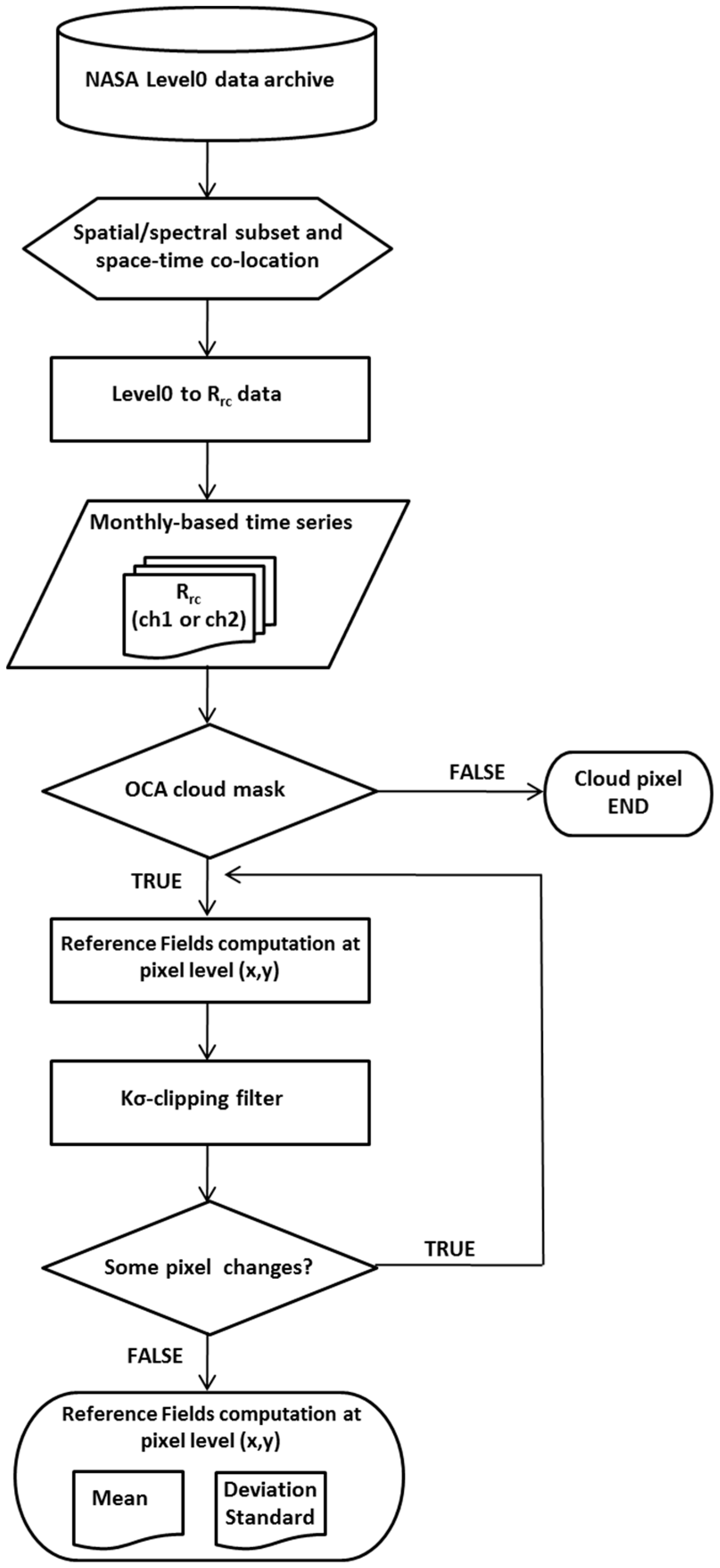

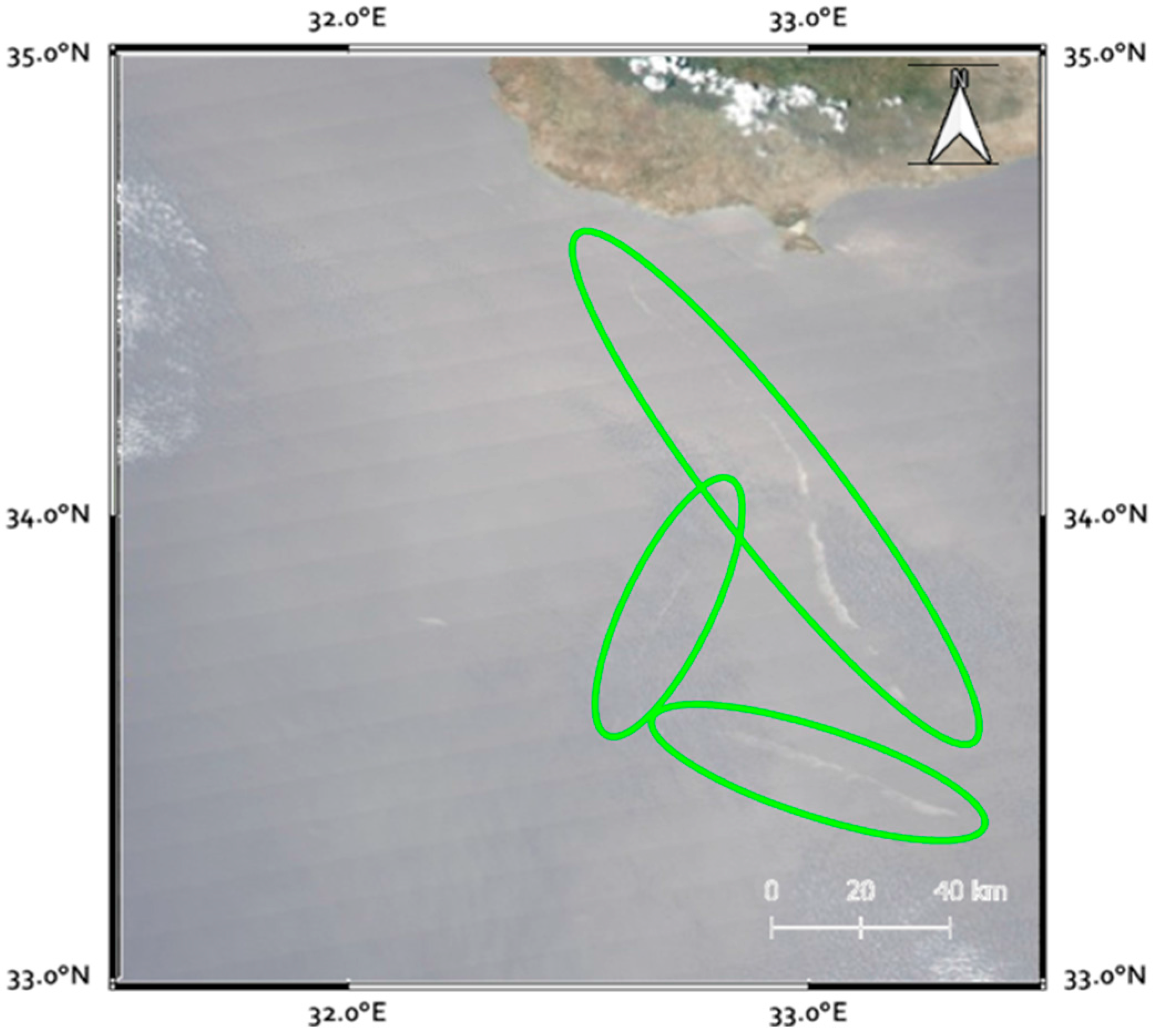
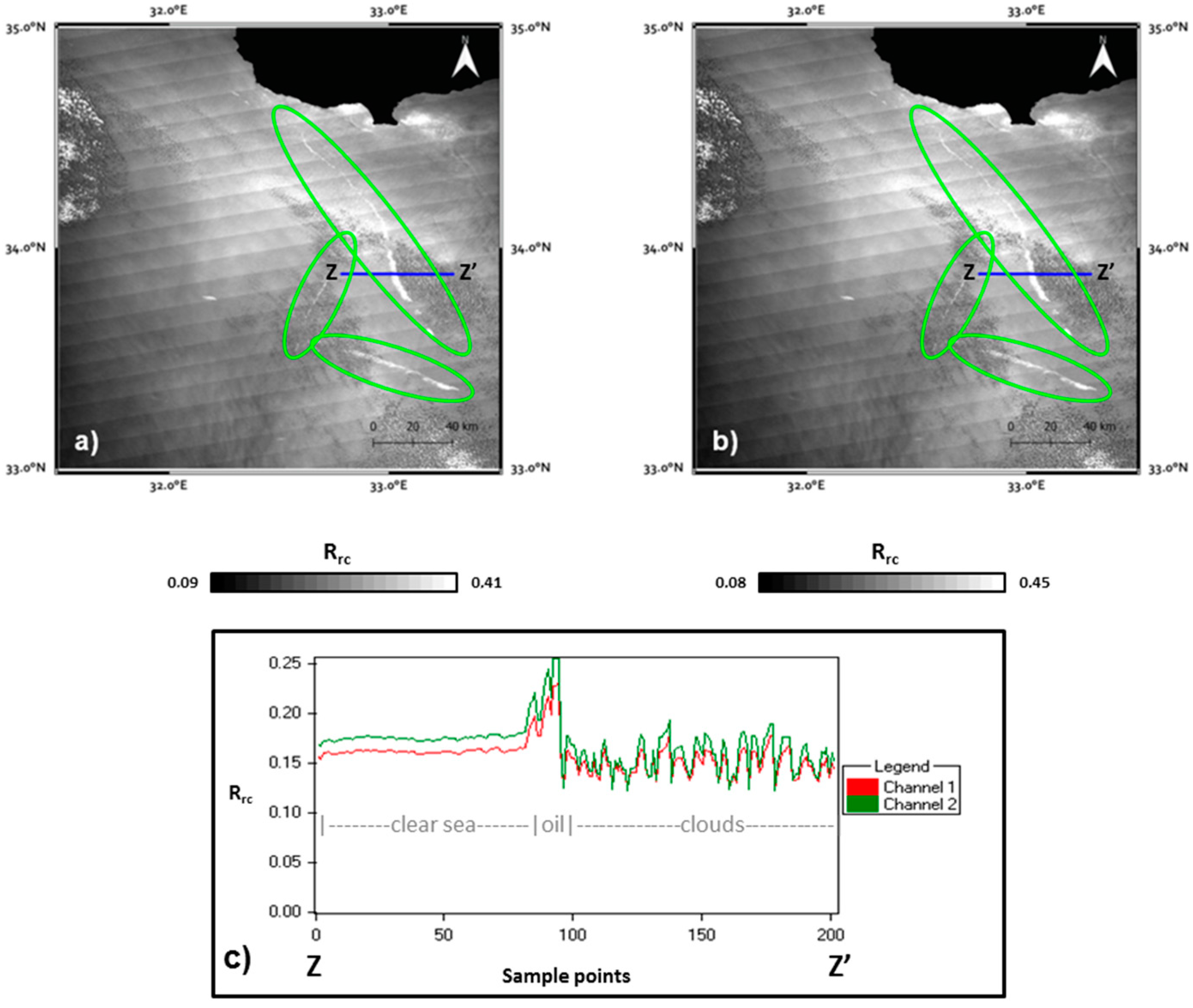
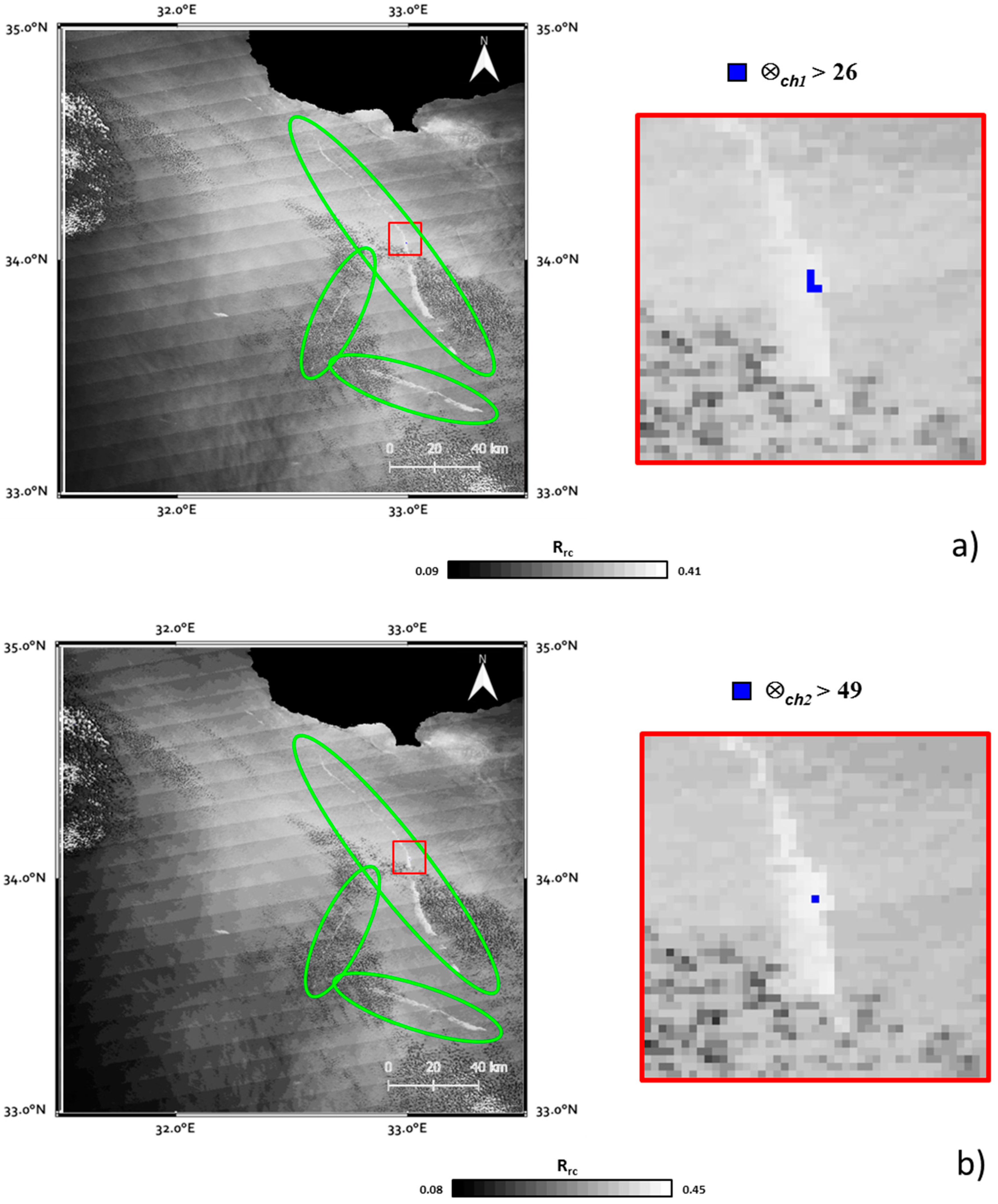

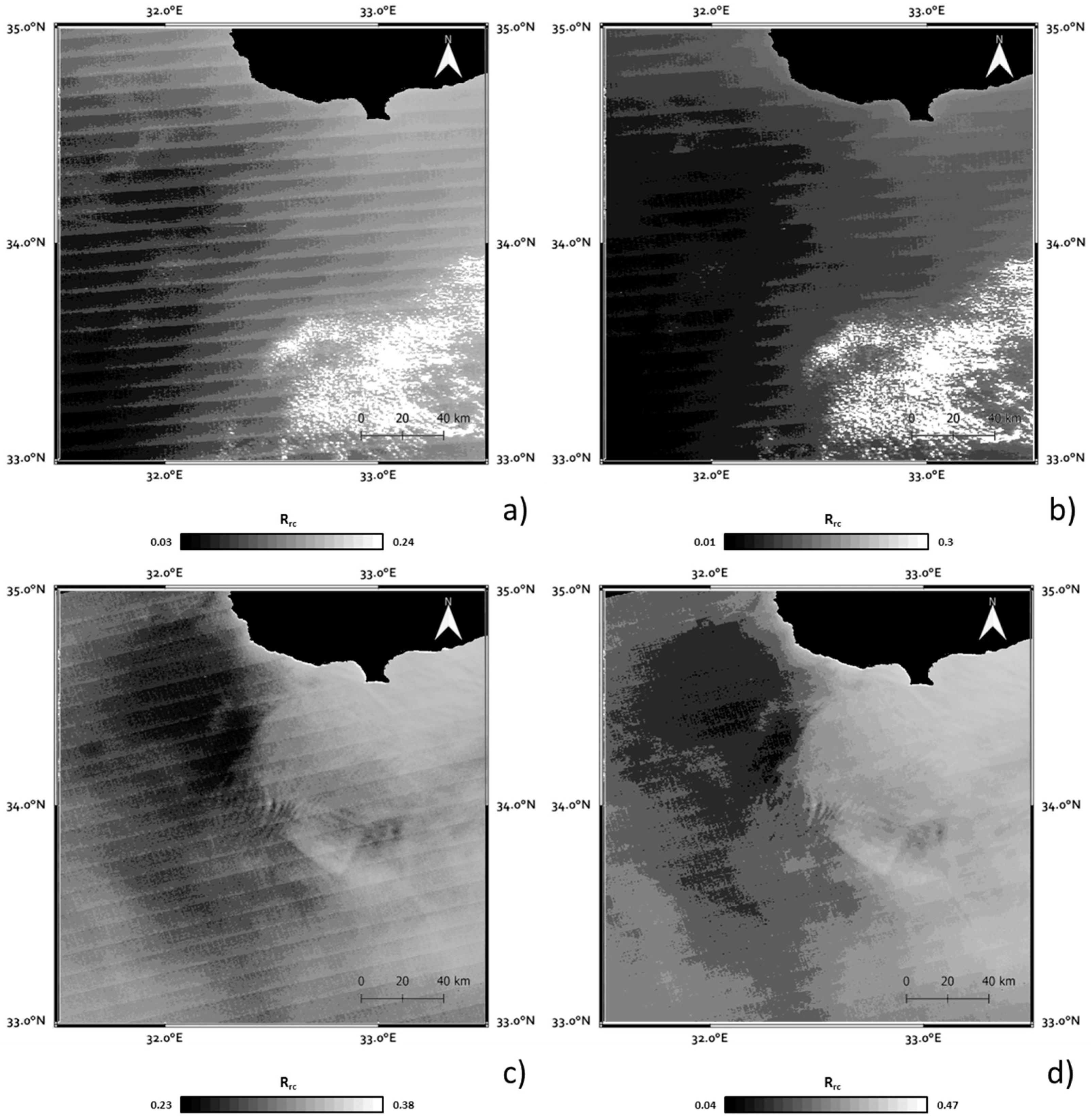
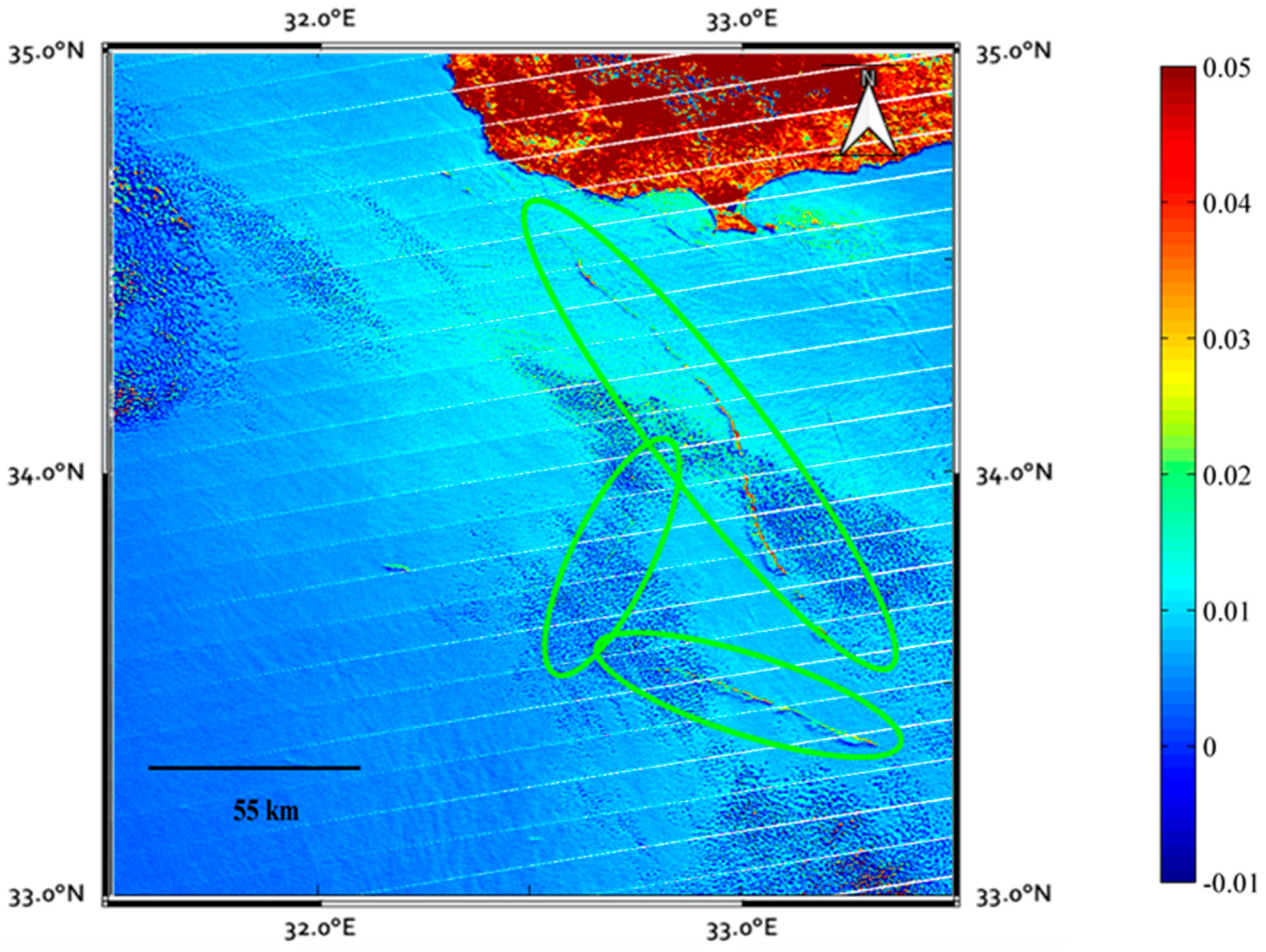
| MODIS-Aqua Image of 18/06/2007 10:50 a.m. GMT | |||
|---|---|---|---|
| X = ⊗ch1 (Figure 7a) | Number Pixels | X = ⊗ch2 (Figure 7b) | Number Pixels |
| 14 < x ≤ 16 | 783 | 22 < x ≤ 27 | 784 |
| 16 < x ≤ 18 | 273 | 27 < x ≤ 32 | 157 |
| 18 < x ≤ 20 | 101 | 32 < x ≤ 37 | 53 |
| 20 < x ≤ 22 | 39 | 37 < x ≤ 42 | 11 |
| 22 < x ≤ 24 | 15 | 42 < x ≤ 47 | 7 |
| 24 < x ≤ 26 | 8 | 47 < x ≤ 49 | 1 |
| x > 26 | 4 | x > 49 | 1 |
| TOT | 1223 | TOT | 1014 |
© 2017 by the authors. Licensee MDPI, Basel, Switzerland. This article is an open access article distributed under the terms and conditions of the Creative Commons Attribution (CC BY) license ( http://creativecommons.org/licenses/by/4.0/).
Share and Cite
Lacava, T.; Ciancia, E.; Coviello, I.; Di Polito, C.; Grimaldi, C.S.L.; Pergola, N.; Satriano, V.; Temimi, M.; Zhao, J.; Tramutoli, V. A MODIS-Based Robust Satellite Technique (RST) for Timely Detection of Oil Spilled Areas. Remote Sens. 2017, 9, 128. https://doi.org/10.3390/rs9020128
Lacava T, Ciancia E, Coviello I, Di Polito C, Grimaldi CSL, Pergola N, Satriano V, Temimi M, Zhao J, Tramutoli V. A MODIS-Based Robust Satellite Technique (RST) for Timely Detection of Oil Spilled Areas. Remote Sensing. 2017; 9(2):128. https://doi.org/10.3390/rs9020128
Chicago/Turabian StyleLacava, Teodosio, Emanuele Ciancia, Irina Coviello, Carmine Di Polito, Caterina S. L. Grimaldi, Nicola Pergola, Valeria Satriano, Marouane Temimi, Jun Zhao, and Valerio Tramutoli. 2017. "A MODIS-Based Robust Satellite Technique (RST) for Timely Detection of Oil Spilled Areas" Remote Sensing 9, no. 2: 128. https://doi.org/10.3390/rs9020128






